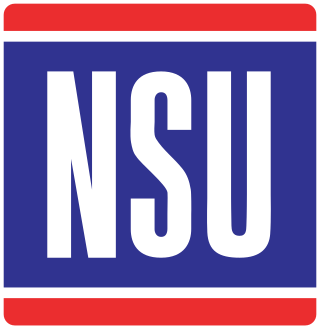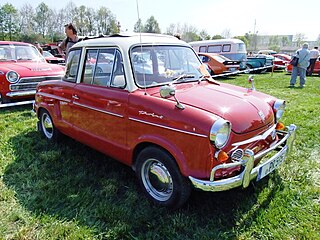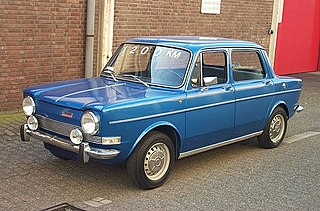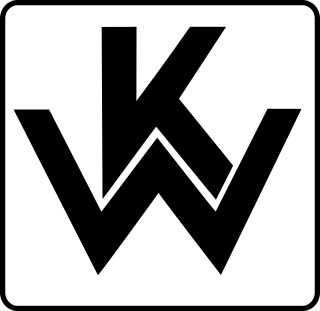History
NSU Motorenwerke (subsequently NSU Werke) AG sold its then recently completed Heilbronn car factory (near the river Neckar) in 1929 to Fiat for one Million Marks, following financial problems resulting from the economic crisis. The deal resulted from an initiative by NSU's bankers, Dresdner Bank. [1]
Two separate NSU businesses
The 1929 deal left two businesses producing petrol driven vehicles with similar names located barely 7 kilometers (4 miles) apart: the two were frequently confused with one other. "NSU Automobil-AG" was a subsidiary of Fiat, manufacturing Fiat passenger cars carrying a "NSU-Fiat" badge and located in Heilbronn, while NSU Werke AG in nearby Neckarsulm produced motor-bikes, becoming during the 1950s one of the largest motor-bike manufacturers in the world. [1]
NSU-Fiat
Fiat's German subsidiary started to produce Fiat Topolinos and Balillas models under license in the Heilbronn factory under the brand "NSU-Fiat". (The same Fiat-designed models were also produced under license in Nanterre, France by SIMCA-Fiat the cars subsequently becoming known simply as "Simcas".)
The Heilbronn plant had been built in 1926 by NSU, then a motor bike manufacturer, in order to break into the passenger car market, but the project had failed and by 1929 NSU had no ambitions to produce passenger cars, and therefore no reason to object when Fiat, having bought the plant, used it to manufacture cars badged as NSU-Fiats. In 1929 friendly collaboration between NSU and the nearby Fiat subsidiary was agreed, with NSU supplying parts for the Heilbronn built Fiat models. A year later, however, relations had cooled as Fiat preferred to supply parts to its Heilbronn factory from its own Turin plant beyond the Alps, and also used the Heilbronn site as a bridgehead to facilitate the importation to Germany of fully assembled new cars from Italy. [1]
Post war sporting success for NSU
Success by NSU Werke AG in motor-bike racing in the decade after 1945 greatly enhanced the appeal and therefore the value, especially in Germany, of the "NSU" name. With the "NSU" name more frequently in the public eye, confusion between "NSU-Fiat" and "NSU Werke" became more frequent among the general public which also affected business professionals with whom the businesses had dealings. The 1950s found NSU Werke's General Director, Dr. von Heydekampf, complaining that customers were being deceived ("grobe Kundentäuschung") because Fiat Germany were using the NSU-Fiat name to exploit the glory of the racing successes and speed records of the NSU motorbikes. [1]
Re-entry into automobiles
In 1955 it was reported that the motorbike manufacturer NSU Werke were planning to produce a passenger car in the "approximately 400cc" class and proposed to badge the little car simply as an "NSU". This seemed likely to create even more confusion in the market place affecting Fiat's smaller "NSU-Fiat"s based on the Fiat 600, already produced in Turin since 1955 and scheduled for imminent launch as a Heilbronn produced model (with the still smaller Fiat 500 already in the development pipeline). [1] The Heilbronn built Fiat 600 was duly launched in 1956, but because of the dispute it was badged not as an NSU-Fiat but as the "Jagst" (shortly thereafter lengthened to "Neckar-Jagst") while one class up, the new Heilbronn built Fiat 1100 also introduced in 1956 was advertised as the "Neckar". [1] The NSU offering, when it appeared on the market in 1958 as the NSU Prinz would indeed compete in the same market segment as the baby Fiats.
NSU brand dispute
Acrimony had mounted, involving robust exchanges of lawyers' letters, and legal hearings ensued. Arguments centred on what had been agreed about rights to the "NSU" name and, in particular, whether an arguably informal letter dated 5 January 1929 on the subject had long-standing contractual force. [1] The judge decided that the 1929 letter could not have the contractual force necessary to bind the parties over use of the "NSU" name, because of a danger that its effect, if valid, would be to damage marketplace competition and thereby run counter to the public interest. [1] The Fiat licensee therefore felt obliged, in 1957, to rebrand all its Heilbronn assembled cars: NSU-Fiat badged cars became Neckars.
Fiat-designed models branded as Neckars
Neckar was in the late 1950s producing fewer than 25,000 vehicles a year, Fiat 500 (Neckar Weinsberg), 600 (Neckar Jagst) and 1100 (Neckar Europa) slightly modified, often more luxurious and sporty than the Fiats produced in Turin.
The launch of the Fiat 1500 in 1961 and of the Neckar Panorama (derived from the Autobianchi Bianchina Panoramica) allowed Neckar to reach a yearly production of 50,000 units in 1962. A coupé derived from the 1500 and called the Neckar Mistral was designed. A coupé and a convertible based on the Fiat 600 were produced as the Neckar Riviera. The Fiat 850 (as the Neckar Adria) was the last model produced by Neckar.

Simca was a French automaker, founded in November 1934 by Fiat S.p.A. and directed from July 1935 to May 1963 by Italian Henri Pigozzi. Simca was affiliated with Fiat and, after Simca bought Ford's French subsidiary, became increasingly controlled by Chrysler. In 1970, Simca became a brand of Chrysler's European business, ending its period as an independent company. Simca disappeared in 1978, when Chrysler divested its European operations to another French automaker, PSA Peugeot Citroën. PSA replaced the Simca brand with Talbot after a short period when some models were badged as Simca-Talbots.

The NSU Ro 80 is a four-door, front-engine executive sedan manufactured and marketed by the West German firm NSU from 1967 until 1977.

NSU Motorenwerke AG, or NSU, was a German manufacturer of automobiles, motorcycles and pedal cycles, founded in 1873. Acquired by Volkswagen Group in 1969, VW merged NSU with Auto Union, creating Audi NSU Auto Union AG, ultimately Audi. The name NSU originated as an abbreviation of "Neckarsulm", the city where NSU was located.

The Fiat 600 is a rear-engine, water-cooled city car, manufactured and marketed by Fiat from 1955 to 1969 — offered in two-door fastback sedan and four-door Multipla mini MPV body styles. It is considered a pop icon of the Italian economic miracle.

The Fiat 1100 is a small family car produced from 1953 until 1969 by the Italian manufacturer Fiat. It was an all-new unibody replacement for the Fiat 1100 E, which descended from the pre-war, body-on-frame Fiat 508 C Balilla 1100. The 1100 was changed steadily and gradually until being replaced by the new Fiat 128 in 1969. There were also a series of light commercial versions of the 1100 built, with later models called the Fiat 1100T, which remained in production until 1971. The Fiat 1100 D also found a long life in India, where Premier Automobiles continued to build the car until the end of 2000.
Lloyd Motoren Werke G.m.b.H. was a German automobile manufacturer, created in 1908 and owned by the Norddeutscher Lloyd shipping company. The factory was in Bremen. The company operated under a variety of different names throughout the decades, but their products were nearly always badged with the Lloyd marque. Originally a manufacturer of luxury cars, the company was folded into the Borgward Group in 1929, with the brand not used on passenger cars again until 1950. Production ended for good in 1963, although a successor company continued trading until 1989, selling replacement parts, as well as manufacturing engines for snowmobiles and boats.
Hansa-Automobil Gesellschaft m.b.H was a German car brand established in 1905, which in 1914 was merged with Norddeutsche Automobil und Motoren AG (NAMAG) into Hansa-Lloyd-Werke A.G.. From 1929 to 1931 it was taken over by the Borgward group. Hansa was based in the Bremen suburb of Hastedt.

The NSU Prinz (Prince) is an automobile which was produced in West Germany by the NSU Motorenwerke AG from 1958 to 1973.

The 508 Balilla was a compact car designed and developed by Fiat in 1932. It was, effectively, the replacement of the Fiat 509, although production of the earlier model had ceased back in 1929. It had a three-speed transmission, seated four, and had a top speed of about 50 mph (80 km/h). It sold for 10,800 lire. About 113,000 were produced.

The Fiat 850 is a small rear-engine, rear-wheel-drive car manufactured and marketed by Italian car manufacturer Fiat from 1964 to 1973.

The Fiat 1300 and Fiat 1500 are a series of front-engine, rear-drive automobiles manufactured and marketed by Fiat from 1961 to 1967, replacing the Fiat 1400 and Fiat 1200 coupé, spyder and cabriolet. The 1300 and 1500 were essentially identical to each other except for their engine displacement, as indicated by their model names, and were offered in sedan/saloon, station wagon, convertible and coupé body styles which shared little mechanically with the other body styles except the 1500 engine.

The Simca 1000, or Simca Mille in French, is a small, boxy rear-engined four-door saloon, manufactured for 18 years by French automaker Simca, from 1961 to 1978.

The NSU Spider is an automobile which was produced by NSU Motorenwerke AG from 1963 to 1967.

Fábrica Nacional de Motores (FNM) was a Brazilian manufacturer of engines and motor vehicles based in the Xerém district of Duque de Caxias near Rio de Janeiro that operated between 1942 and 1988. In 2018, the manufacturer was refounded, changing its name to Fábrica Nacional de Mobilidades based in Rio de Janeiro and producing electric trucks at the Agrale factory in Rio Grande do Sul.

The NSU Typ 110 is a small car that was made by NSU between 1965 and 1972. It was first presented at the 1965 Frankfurt Motor Show, widening NSU's range in the process. It was based on the NSU Prinz 1000 but with a longer wheelbase and a front overhang which increased available space both in the passenger cabin and in the luggage compartment. With an external length of four metres the car took NSU into the lower rungs of the middle class saloon sector, as it existed at that time in West Germany. It was to distance the model from the small car sector that for this model NSU abandoned the Prinz name which had till then been carried by their passenger cars.

The automotive industry in Germany is one of the largest employers in the world, with a labor force of over 857,336 (2016) working in the industry.
France was a pioneer in the automotive industry and is the 11th-largest automobile manufacturer in the world by 2015 unit production and the third-largest in Europe. It had consistently been the 4th-largest from the end of World War II up to 2000. It is 16 % of sales of French manufactured products.
The NSU/Fiat Weinsberg 500 is a Fiat automobile. It was produced in two versions based on the Fiat 500 (1957–1975). Like the Neckar Pully, the Weinsberg was the creation of NSU/FIAT Karosseriewerke Weinsberg, made possible because NSU/FIAT in Heilbronn also had its own development department, in which designers such as Antonio Fessia worked. Introduced in March 1959 as the NSU/Fiat, 6,228 vehicles were manufactured from 1959 to 1963. The price was 3,840 DM in 1959, 3620DM in 1962.
The Deutsche Automobil-Industrie Hering & Richard was a German company which produced motor vehicles in its factory in Gera-Untermhaus. From 1904 the company headquarters was in Ronneburg (Thuringia). Models were produced under the brand names Rex and Rex-Simplex between 1901 and 1923, using engines from De Dion-Bouton and/or Fafnir. Rex-Simplex models were produced under licence elsewhere, e.g. by Russo-Balt.

The Karosseriewerke Weinsberg, abbreviated KW, is a German Tooling Company based in Bretzfeld. Originally, it was founded as a Weinsberg-based car coachbuilder, that was known for their recreational vehicles. The city name Weinsberg was used as brand name from 1969 to 1992.

















